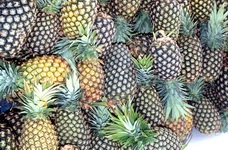
Pineapple Genome Unlocked; Gives Insight into Photosynthesis in Drought Tolerant Plants
November 4, 2015| |
 Pineapple has been cultivated for more than 6,000 years, thriving in water-starved environments. To understand how pineapples grow to be juicy under such conditions, researchers at the University of Illinois at Urbana-Champaign took a closer look at the plant's genes and genetic pathways.
Pineapple has been cultivated for more than 6,000 years, thriving in water-starved environments. To understand how pineapples grow to be juicy under such conditions, researchers at the University of Illinois at Urbana-Champaign took a closer look at the plant's genes and genetic pathways.
The researchers, led by biology professor Ray Ming, found that pineapple share ancestors with sorghum and rice. Like many plants, the ancestors of pineapple experienced multiple doublings of their genomes, so the researchers tracked the remnants of these "whole-genome duplications" to trace the plant's evolutionary history.
The team found that pineapple uses a special type of photosynthesis called crassulacean acid metabolism (CAM), while most plants use C3 photosynthesis. Ming said that CAM plants use only 20 percent of the water used by typical C3 plants, and CAM plants can grow in dry, marginal lands that are unsuited for most plants. The genome revealed that some genes that contribute to CAM photosynthesis are regulated by the plant's circadian clock genes, which allow plants to differentiate day and night and adjust their metabolism accordingly. "This is the first time scientists have found a link between regulatory elements of CAM photosynthesis genes and circadian clock regulation," Ming said.
For more information, read the news release at the Illinois News Bureau.
| |
Biotech Updates is a weekly newsletter of ISAAA, a not-for-profit organization. It is distributed for free to over 22,000 subscribers worldwide to inform them about the key developments in biosciences, especially in biotechnology. Your support will help us in our mission to feed the world with knowledge. You can help by donating as little as $10.
-
See more articles:
-
News from Around the World
- AfDB Approves Loan to Promote Science and Technology in Angola
- Scientists Uncover How Plants Thrive Using Natural Mechanism to Recycle Chloroplasts
- BTI Scientists Develop New Technique to Boost Beta-carotene in Tubers
- Pineapple Genome Unlocked; Gives Insight into Photosynthesis in Drought Tolerant Plants
- China's Seed Law Amended
- Australian Researchers Discover Key Gene to Improve Barley's Drought Tolerance
- European Parliament Rejects National GMO Bans Proposal
-
Research Highlights
- GhACL5 Gene is Involved in Stem Elongation and Plant Defense Response to Verticillium dahliae
- AtRAV1 and AtRAV2 Overexpression in Cotton Increases Fiber Length and Delays Flowering under Drought Stress
- Promoter Difference of LcFT1 is the Cause of Natural Variation of Flowering in Litchi
- OsNF-YA7 Transcription Factor Confers Drought Stress Tolerance in Rice
-
Beyond Crop Biotech
- Metabolic Engineering of Pichia pastoris for the Production of Dammarenediol-II
-
From the BICs
- Agri Extension Service Providers in Uganda Hone Biotech Communication Skills
- UBIC Conducts Maiden Forum on Agri-biotech at Bukalasa Agricultural College
-
Resources
- New Pocket K: Coexistence of Biotech and Non-biotech Crops
-
Read the latest: - Biotech Updates (April 17, 2024)
- Gene Editing Supplement (April 10, 2024)
- Gene Drive Supplement (February 22, 2023)
-
Subscribe to BU: - Share
- Tweet
